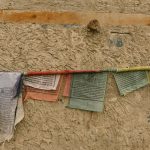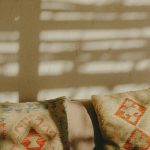You’ll find popular batik designs like Parang, with its bold diagonal lines symbolizing strength and nobility, and Kawung, featuring circular motifs that represent purity and harmony. Mega Mendung offers calming cloud shapes reflecting hope and protection, while Sekar Jagad bursts with vibrant floral motifs celebrating unity. Truntum’s delicate star-like dots stand for everlasting love. Each pattern carries deep meaning and rich artistry, and there’s even more fascinating batik styles waiting to inspire your appreciation.
Table of Contents
Key Takeaways
- Parang pattern features diagonal lines symbolizing strength and nobility, traditionally worn by Javanese royalty.
- Kawung design uses circular motifs representing purity and spiritual harmony, often worn during important ceremonies.
- Mega Mendung motif depicts layered cloud shapes symbolizing protection, fertility, and hope from Cirebon culture.
- Sekar Jagad pattern showcases intricate floral designs expressing unity, diversity, and positive community energy.
- Truntum design includes star-like dots symbolizing everlasting love and new beginnings, commonly worn at weddings.
Parang Pattern
The Parang Pattern stands out as one of the oldest and most revered designs in batik fabric. When you look closely, you’ll notice its distinctive diagonal lines that resemble waves or knife blades.
The Parang Pattern features iconic diagonal lines, evoking waves or blades, marking it as a timeless batik classic.
This pattern symbolizes strength, courage, and continuous struggle, reminding you to face challenges head-on. Traditionally, the Parang was worn by Javanese royalty, so it carries a sense of nobility and power.
You’ll find the design intertwines smoothly, creating a dynamic flow that keeps your eyes engaged. Choosing a batik with the Parang Pattern means you’re embracing a deep cultural heritage while making a bold statement.
It’s not just beautiful—it’s meaningful, connecting you to centuries of artistry and philosophy embedded in every fabric strand.
Kawung Design
If the Parang Pattern speaks to strength and boldness, the Kawung Design offers a different kind of elegance rooted in simplicity and balance.
When you look closely, you’ll notice its distinctive circular motifs resembling the cross-section of a palm fruit or a flower. These repeating oval shapes create a symmetrical and calming effect that feels both timeless and refined.
You’ll find that the Kawung Design often symbolizes purity, honesty, and spiritual harmony. It’s a pattern that’s traditionally worn during important ceremonies, reflecting a deep cultural meaning.
When you choose batik with Kawung motifs, you’re embracing a style that combines understated beauty with rich symbolism, making it a perfect choice if you appreciate subtlety and classic artistry in fabric design.
Mega Mendung Motif
You’ll find the Mega Mendung motif rooted in Indonesian culture, symbolizing clouds and protection.
Its design features rounded, layered shapes with deep blue and gray tones that evoke stormy skies.
Understanding these elements helps you appreciate the pattern’s rich meaning and striking appearance.
Origins and Cultural Significance
While exploring Batik’s rich history, you’ll find the Mega Mendung motif stands out with its unique cloud-like patterns inspired by the skies of West Java.
This design originates from the Cirebon region, where it symbolizes the clouds that bring life-giving rain. You’ll see the motif representing protection, fertility, and spiritual balance, reflecting the deep connection locals have with nature and their environment.
When you wear or use Mega Mendung Batik, you’re embracing these values and the cultural heritage passed down through generations.
The motif also conveys hope and resilience, reminding you of the skies’ ever-changing nature and the promise of renewal. Understanding its origins helps you appreciate the profound meaning behind this iconic Batik pattern.
Design Characteristics and Colors
The Mega Mendung motif captivates with its sweeping, cloud-like shapes that flow gracefully across the fabric. You’ll notice the design’s bold outlines and layered curves, which symbolize rain clouds bringing fertility and hope. The colors usually blend deep blues, grays, and soft whites, creating a calming yet dynamic visual effect. This combination reflects the motif’s connection to nature and spirituality.
| Design Element | Description |
|---|---|
| Shapes | Rounded, cloud-like swirls |
| Colors | Blues, grays, white accents |
| Symbolism | Fertility, hope, spirituality |
| Pattern Layout | Repeating, flowing arrangement |
When you wear Mega Mendung batik, you carry a piece of cultural depth and natural beauty with you.
Sekar Jagad Pattern
Sekar Jagad Pattern captures the vibrant spirit of unity through its intricate floral motifs symbolizing the harmony of the universe.
When you wear or use this batik, you embrace a design that reflects diversity and interconnectedness, blending various flower shapes and colors seamlessly.
This pattern often features bright, contrasting hues that draw your eye to the detailed craftsmanship. You’ll notice the balance between complexity and order, as each element complements the whole without overwhelming it.
Sekar Jagad is traditionally associated with positive energy and a sense of community, making it perfect for occasions where you want to express togetherness and goodwill.
Truntum Design
When you explore the Truntum Design, you’ll find a pattern rich with symbolism and meaning. This iconic batik motif features small, star-like dots arranged in circular formations, symbolizing everlasting love and guidance.
Traditionally, it’s worn during weddings, representing the enduring bond between partners. The name “Truntum” means “to grow” or “to sprout,” reflecting new beginnings and hope.
You’ll notice its delicate, repetitive dots create a mesmerizing effect, making the fabric both elegant and meaningful. If you choose batik with Truntum, you’re embracing tradition and deep cultural stories.
It’s more than just a design—it’s a message of love that continues to grow, making it a timeless favorite in the world of batik patterns.
Lereng Pattern
If you appreciated the delicate symbolism of the Truntum Design, you’ll find the Lereng Pattern offers a striking contrast with its bold, angular lines.
This pattern features diagonal stripes that create a dynamic sense of movement and energy. You’ll often see Lereng in vibrant colors, which enhance its visual impact and make it stand out.
Traditionally, Lereng symbolizes progress and forward momentum, encouraging you to embrace change and growth.
Its simplicity and geometric nature make it versatile, suitable for both casual wear and formal occasions.
When you choose batik fabric with the Lereng Pattern, you’re not just picking a design—you’re selecting a motif that inspires confidence and liveliness in your everyday style.
Ceplok Motif
The Ceplok Motif captivates with its intricate, symmetrical patterns that repeat like a mesmerizing puzzle. When you look closely, you’ll notice geometric shapes—often squares, diamonds, or hexagons—carefully arranged to create a harmonious rhythm.
This motif’s precision and balance symbolize order and harmony in Javanese culture. You’ll find it commonly in traditional batik from Central Java, where artisans meticulously draw and wax each element before dyeing.
The repetitive nature of Ceplok makes it versatile; you can wear it casually or at formal events and still stand out. By choosing Ceplok, you embrace a timeless design rooted in history but still fresh and dynamic.
It’s a perfect way to connect with the artistry and symbolism of classic Indonesian batik.
Sidomukti Design
Sidomukti Design embodies prosperity and well-being through its elegant motifs filled with symbolic meaning.
When you wear or display this batik pattern, you’re embracing wishes for good fortune, happiness, and harmony. The design often features floral elements combined with geometric shapes, representing growth and balance in life.
You’ll notice the intricate details that reflect traditional Javanese values, making Sidomukti not just beautiful but deeply meaningful. This pattern suits formal occasions or ceremonies where blessings and positive energy are desired.
Frequently Asked Questions
How Is Batik Fabric Traditionally Made?
You create batik fabric by applying hot wax to cloth in patterns, then dyeing the fabric. The wax resists the dye, preserving designs. After dyeing, you remove the wax, revealing intricate, colorful patterns on the fabric.
What Tools Are Used in Creating Batik Patterns?
Did you know artisans use a canting tool to draw intricate patterns by hand? You’ll also work with a copper stamp called a cap for repetitive designs, plus wax and dyes to create stunning batik fabrics.
What Cultural Significance Does Batik Hold in Indonesia?
You’ll find batik holds deep cultural significance in Indonesia, symbolizing heritage, identity, and social status. It’s used in ceremonies and rituals, reflecting local beliefs, history, and artistry passed down through generations.
How Do Modern Batik Patterns Differ From Traditional Ones?
Imagine your grandma’s quilt beside your sleek, minimalist blanket—modern batik patterns blend bold colors and abstract motifs, unlike traditional intricate designs. You’ll see innovation mixing with heritage, making each piece a fresh story woven from the past.
Can Batik Fabric Be Used for Purposes Other Than Clothing?
You can definitely use batik fabric beyond clothing. It’s great for home decor like pillows, curtains, and wall hangings. You’ll also find it in accessories such as bags and scarves, adding unique style everywhere.
- Tetron Fabric for Marine Applications: Durability and Use Cases - June 18, 2025
- Tetron Fabric for Outdoor Furniture: Weather Resistance and Care - June 18, 2025
- Tetron Fabric for Wall Coverings: Style and Application Tips - June 18, 2025






